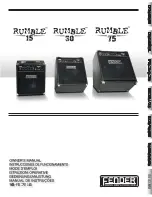
50
...........................................................................................................
<Ring Modulator>
The Ring Modulator multiples the waveforms of two Tones,
creating a new sound that includes many harmonics (inhar-
monic partials) not present in the two original Tones. (As
long as one Tone’s waveform is not a sine wave, virtually no
frequency components sound at regular intervals). As the
pitch difference between the two waveforms changes the
harmonic structure, the result will be an unpitched metallic
sound. This is especially suitable for creating bell and other
metallic sounds.
...........................................................................................................
Tone Key Range Lower: Upper display
On this display, you can specify the range of notes that will
play each Tone. This can be used to make notes in different
areas of the keyboard play different Tones. The specified
range is displayed graphically.
Tone 1 (Tone 1 key range lower:upper)
Tone 2 (Tone 2 key range lower:upper)
Tone 3 (Tone 3 key range lower:upper)
Tone 4 (Tone 4 key range lower:upper)
Lower specifies the lowest note to play each Tone and Upper
specifies the highest, over the C-1 to G9 range.
✳
You cannot set Lower to a value greater than Upper, or
Upper to a value smaller than Lower. If you should do
this by mistake, the two values will change together. If
this is the case, reset the value.
✳
If you have used [+OCT] or [-OCT] or the Transpose
parameter (SYSTEM/Setup/Setup) to transpose the
pitch of the XP-80’s keyboard, the keyboard area speci-
fied by Key Range will also shift.
Tone Vel Range Lower:Upper:Fade (Tone velocity
range) display
Here you can specify the range of velocities that will play
each Tone. You can make different velocities play different
Tones. The specified range is displayed graphically.
Tone 1 (Tone 1 velocity range lower:upper:crossfade)
Tone 2 (Tone 2 velocity range lower:upper:crossfade)
Tone 3 (Tone 3 velocity range lower:upper:crossfade)
Tone 4 (Tone 4 velocity range lower:upper:crossfade)
Lower specifies the lowest velocity limit to play each Tone,
over the range of 1 to 127. Notes played softer than the set
limit will not sound at all or be hardly audible.
Upper specifies the highest velocity limit to play each Tone,
over the range of 1 to 127. Notes played more stronger than
the set limit will not sound at all or be hardly audible.
Crossfade specifies how the volume of the Tone changes
when the velocity of a note is outside the specified velocity
range. Higher settings will result in a more gradual attenua-
tion. If you don’t want the Tone to sound at all for velocities
outside the specified range, set this parameter to 0.
✳
Lower cannot have a value greater than Upper, or
Upper any value smaller than Lower. If you should do
this by mistake, the two values will change together. If
this is the case, reset the value.
Switch (Velocity range switch)
Specifies if the velocity range setting will be used or not. The
velocity range setting is used when the Switch parameter is
ON.
+ =
Lower
Upper
Lower Upper Crossfade
1
parameter value
Level
Velocity
Lower
Upper
parameter value
Chapter 3. Creating your own sounds
[PATCH]
➞
[F1] (Common)
➞
[F4] (K.Range)/[F5] (V.Range)
Summary of Contents for XP-60
Page 245: ...245 ...
















































